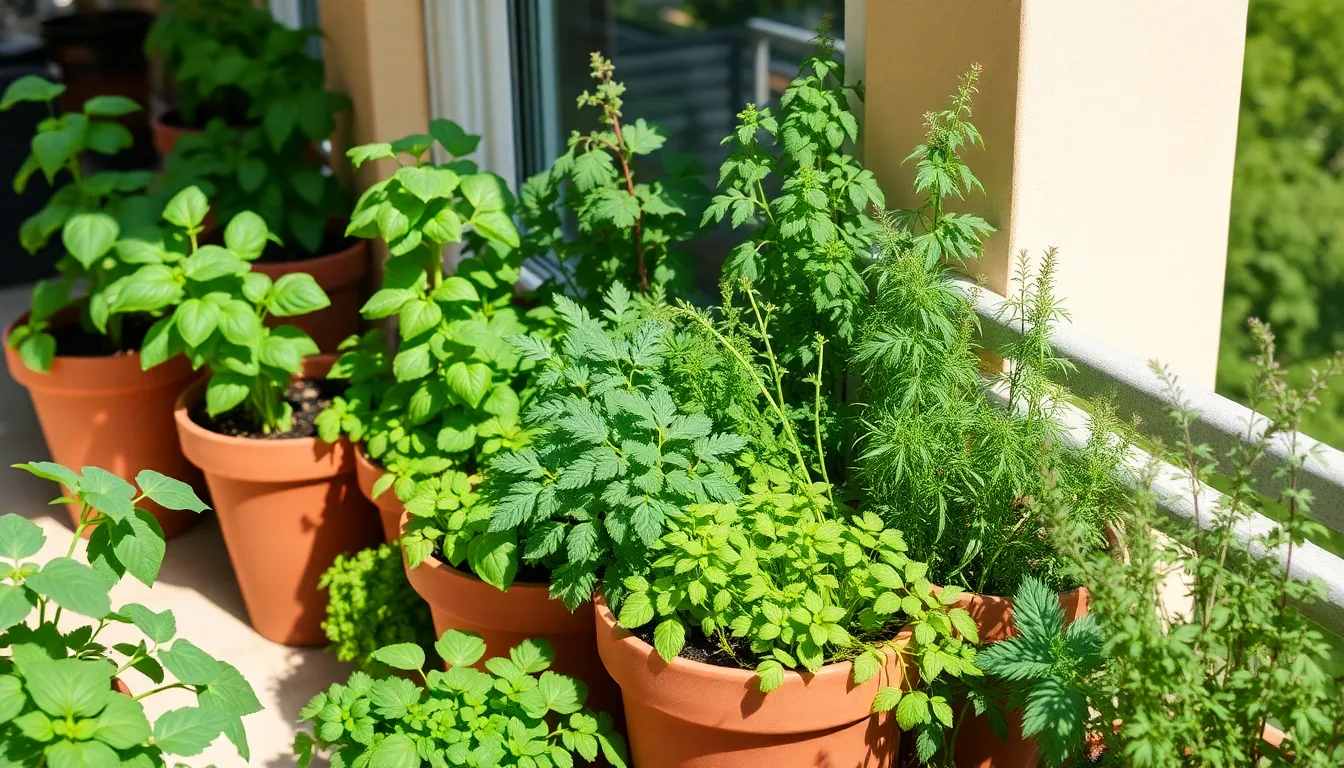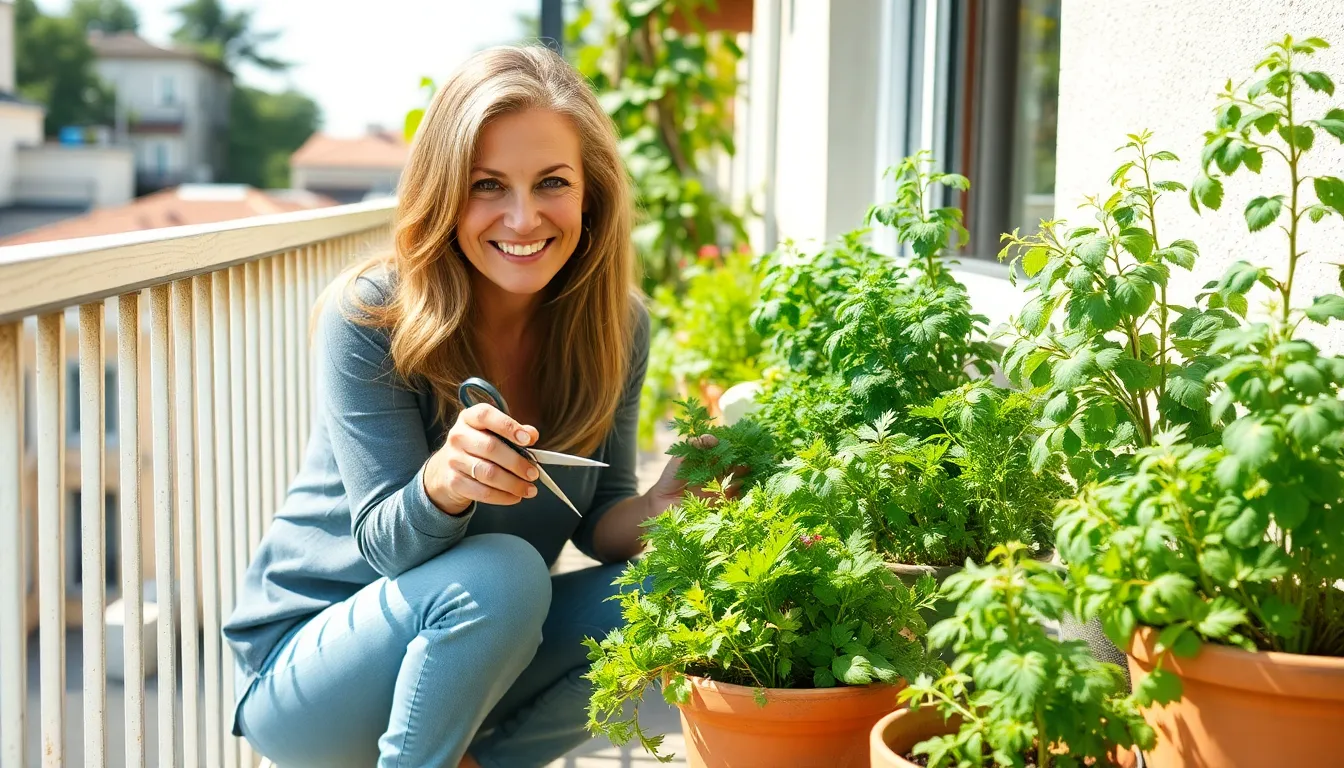Imagine stepping into your kitchen and plucking fresh basil or thyme right from your own home herb garden. It’s like having a mini grocery store at your fingertips, minus the awkward small talk with the cashier. Growing herbs at home isn’t just for the green-thumbed elite; it’s a fun and rewarding project anyone can tackle.
Table of Contents
ToggleBenefits of a Home Herb Garden
Growing a home herb garden offers numerous advantages. It provides fresh ingredients and promotes personal wellness.
Freshness and Flavor
Fresh herbs enhance meals with vibrant flavors. They taste significantly better than dried alternatives, adding depth to dishes like pastas and salads. Herbs maintain their aroma and taste due to the proximity of the garden to the kitchen. Instant access to herbs encourages experimentation with recipes. Maintaining a home herb garden ensures a constant supply of basil, cilantro, and parsley, which elevates culinary experiences.
Health Benefits
Home herbs deliver various health benefits. Many herbs contain antioxidants that combat free radicals. For instance, basil and rosemary contain properties that may boost immune function. Regular consumption of fresh herbs can aid in digestion and promote overall wellness. They offer natural remedies for common ailments, such as nausea and inflammation. Incorporating herbs like mint and ginger into daily meals can enhance nutrient intake significantly.
Choosing the Right Herbs

Selecting the right herbs plays a significant role in creating a successful home herb garden. Different herbs offer distinct flavors and uses, making the choice crucial for culinary enjoyment.
Popular Herb Selections
Basil shines as a favorite for pesto and salads. Cilantro adds freshness to salsas and Asian dishes. Parsley, commonly used as a garnish, complements numerous recipes. Mint refreshes drinks and desserts alike. Oregano brings depth to Italian cuisine and roasted meals. Thyme enhances meats, vegetables, and stews. According to the National Gardening Association, these herbs consistently rank among the most popular for home gardeners due to their versatility and ease of growth.
Seasonal Considerations
Seasonal factors significantly impact herb growth cycles. Warm-weather herbs like basil and oregano thrive during spring and summer. Cooler months suit herbs like cilantro and parsley, which prefer milder temperatures. Planting specific herbs at the right time ensures optimal flavors and health benefits. Consult local planting calendars for precise timing. Adjusting planting habits based on seasonal changes maximizes harvest potential and enhances overall garden success.
Planning Your Herb Garden
Planning an herb garden requires careful consideration of space and method. Specific factors influence the overall success of the garden.
Space Requirements
Available space dictates the number of herbs that can be grown. A small balcony accommodates several pots, while a larger garden can host an extensive array. It’s essential to factor in sunlight exposure, as most herbs thrive in direct sunlight for six to eight hours daily. Assessing airflow around the plants also plays a crucial role in preventing diseases.
Container vs. In-Ground Options
Choosing between container and in-ground options depends on preferences and available space. Containers offer flexibility and mobility, allowing herbs to be repositioned for optimal light. They also work well for those with limited yard space. On the other hand, in-ground planting provides unrestricted growth, allowing herb roots to expand fully. Soil quality and drainage significantly affect the health of in-ground herbs.
Maintenance and Care
Maintaining a home herb garden requires attention to watering, soil, pests, and protection strategies. Each aspect contributes significantly to the overall health and productivity of the herb plants.
Watering and Soil Needs
Watering frequency directly affects herb growth. Herbs typically require moist, well-drained soil to thrive. Before watering, check the top inch of soil; if it’s dry, it’s time to water. Consistently water when plants are young, ensuring the moisture reaches the roots without oversaturation. Drainage plays a key role as well; herbs dislike soggy roots, making pots with drainage holes essential. Choose a high-quality potting mix rich in organic matter for container gardens. A combination of compost and well-draining materials like perlite ensures optimal conditions for thriving herbs.
Pest Control and Protection
Healthy herbs attract beneficial insects, helping control harmful pests. Implement regular inspections to identify early signs of infestations. Common pests include aphids and spider mites, which can be managed using insecticidal soap or neem oil as a natural remedy. Surrounding plants with garlic or marigold can deter pests naturally without harmful chemicals. Encouraging predatory insects like ladybugs also provides a natural pest protection method. Covering plants with netting or fabric can shield them from birds and larger pests. Implementing these practices promotes a vibrant, productive herb garden.
Harvesting Your Herbs
Harvesting herbs at the right time enhances flavor and encourages growth. Herbs should be harvested in the morning after the dew has dried but before the heat of the day. When cutting, use sharp scissors or shears to prevent damage. For most herbs, a general rule is to remove about one-third of the plant, allowing the remaining leaves to continue thriving. A clean cut helps promote regrowth and healthy plants. Frequent harvesting encourages bushier growth and a more abundant harvest.
Best Practices for Harvesting
Timing matters when harvesting herbs to maximize flavor. Picking leaves regularly encourages growth and ensures richer flavors. Snipping leaves from the top stimulates the plant to produce more branches. Avoid stripping too many leaves from one area to promote a balanced growth habit. Different herbs may require varying techniques; for instance, basil benefits from regular frequent harvesting, while chives can be cut down to about an inch from the ground. Ensure no damage to stems or roots while harvesting to maintain plant health.
Preserving and Using Herbs
Preservation techniques vary based on intended use, with common methods including drying, freezing, and making herb-infused oils. To dry herbs, tie them in small bundles and hang them in a cool, dark area. Freezing offers another effective way to keep herbs fresh; simply chop herbs, place them in ice cube trays, and fill with water or olive oil. Infused oils enhance dishes; steep fresh herbs in oil for several weeks to extract flavors. Fresh herbs amplify culinary creations, enhancing everything from salads to sauces. Enjoy herbs in various forms to enrich meals and snacks.
A home herb garden offers an enriching experience that enhances culinary creativity and promotes well-being. By cultivating fresh herbs, individuals can enjoy the satisfaction of growing their own ingredients while benefiting from the superior flavors and health advantages they provide. With the right planning and care, anyone can create a thriving herb garden that fits their space and lifestyle.
Whether it’s a small balcony or a spacious backyard, the joy of harvesting herbs directly from one’s garden is unmatched. Embracing this rewarding hobby not only elevates meals but also fosters a deeper connection to food and nature. Starting a home herb garden is a step toward a healthier and more flavorful life.




